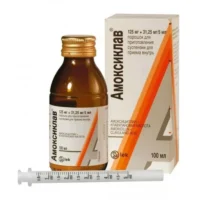Description
Amoxiclav (Amoxicillin) Quicktab Tablets 500 mg/125 mg. №20
Ingredients
Each tablet contains: Amoxicillin (as trihydrate) 500 mg, Clavulanic acid (as potassium salt) 125 mg.
Mechanism of Action
Amoxiclav combines amoxicillin, a penicillin-class antibacterial, with clavulanic acid, a beta-lactamase inhibitor. This combination extends the spectrum of activity of amoxicillin to include bacteria normally resistant to amoxicillin alone.
Pharmacological Properties
Amoxicillin inhibits bacterial cell wall synthesis by binding to penicillin-binding proteins, while clavulanic acid prevents bacterial enzymes from degrading amoxicillin. This dual action enhances the antibacterial effect of amoxicillin.
Indications for Use
Amoxiclav Quicktab tablets are indicated for the treatment of infections caused by susceptible bacteria. These include respiratory tract infections, urinary tract infections, skin and soft tissue infections, intra-abdominal infections, and bone and joint infections.
Contraindications
Do not use Amoxiclav if you are allergic to penicillin or cephalosporin antibiotics. Consult your healthcare provider before taking this medication if you have a history of liver problems, infectious mononucleosis, or lymphatic leukemia.
Side Effects
Common side effects of Amoxiclav may include diarrhea, nausea, vomiting, rash, and hypersensitivity reactions. Severe allergic reactions such as anaphylaxis are rare but possible. Contact your doctor if you experience any adverse effects.
Usage Instructions
The usual dosage for adults and children over 12 years old is one tablet (500 mg/125 mg) every 8 hours. Dosage adjustments may be necessary for patients with renal impairment. Take each tablet with a full glass of water, without crushing or chewing, to ensure proper absorption.
Benefits Compared to Analogues
Amoxiclav Quicktab tablets offer the advantage of a convenient dosing regimen with the combination of amoxicillin and clavulanic acid, providing broad-spectrum coverage against resistant bacteria. This formulation reduces the need for multiple antibiotic therapies in certain infections.
Suitable Patient Groups
Amoxiclav Quicktab tablets are suitable for use in adults, adolescents, and children over 12 years old. Dosage adjustments are necessary for pediatric patients based on weight and severity of the infection. Elderly patients may require dosage modifications due to age-related changes in drug metabolism.
Storage and Shelf Life
Store Amoxiclav Quicktab tablets in a cool, dry place below 25°C. Keep the tablets in their original packaging to protect from moisture. The shelf life of the product is typically 2 years from the manufacturing date.
Packaging Description
Each package of Amoxiclav Quicktab tablets contains 20 tablets. The tablets are blister-packed for individual dose protection and convenience. The packaging is designed to maintain the stability and integrity of the tablets throughout the shelf life.
Scientific Evidence
Amoxiclav (Amoxicillin) Quicktab tablets have shown significant efficacy in treating various bacterial infections. Clinical studies have demonstrated the effectiveness of the combination of amoxicillin and clavulanic acid in combating antibiotic-resistant bacteria.
Additional Information
It is crucial to complete the full course of treatment with Amoxiclav Quicktab tablets as prescribed by your healthcare provider. Incomplete treatment may lead to treatment failure and the development of antibiotic resistance. Inform your doctor about any concurrent medications, especially probenecid or allopurinol, to prevent drug interactions.





